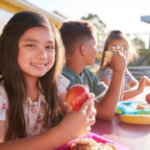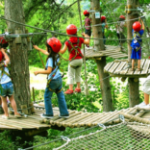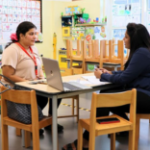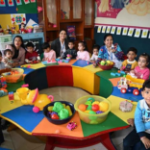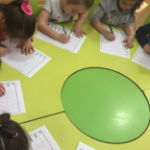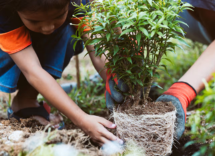
In today’s world, concerns about the environment are at the forefront of global discussions, and it is important to inculcate a sense of responsibility and care for our planet in the youngest members of society. Early childhood education plays a pivotal role in shaping the future attitudes of a child toward sustainability. The teaching of children to respect nature and adopt sustainable habits from an early age can lay the foundation for a generation of environmentally-conscious individuals.
At Tiny Tots International School, sustainability is more than just a concept but also a practice interwoven with the everyday learning fabric. By incorporating eco-friendly practices and environmental education into the preschool curriculum, children not only learn about the world around them but also how to protect and preserve it.
The Importance of Teaching Sustainability Early
The early years in a child’s life are highly significant in terms of cognitive, emotional, and social development. Children learn habits and values in early childhood, which tend to continue for a lifetime. If a child learns about sustainability in their early years, he will develop the importance of preserving the environment, conserving resources, and making responsible choices. Such value formation tends to become the nature of the child as he or she grows.
Sustainable practices in early childhood education do more than teach children about the environment; they also promote creativity, problem-solving, and critical thinking. These practices encourage children to think about the impact of their actions and decisions on the world around them. For instance, when a child is involved in recycling or planting a garden, they not only learn about these actions but also develop a deeper connection to the planet.
In many ways, preschools, including the Tiny Tots International School, engage in sustainable practices in their program. Below are some strategies used effectively in teaching children how to care for the environment:
Introduce Recycling and Waste Management
This can be well implemented if one teaches their children on the importance of reusing items through proper methods of segregation and recycling in terms of sustainability. Through such learning experiences, youngsters find that the fun factor involved is teaching them to take separate containers for paper, plastics, and organic wastes. Children start perceiving and getting involved with the sense of using reutilization and minimizing the environment from such everyday practice.
Teachers can encourage kids to create art projects from recycled materials. This is not only a lesson on reusing but also creativity. Projects, for instance, in making paper flowers from old newspapers or in building sculptures from plastic bottles teach children that the waste materials can take another life when used creatively.
Gardening and Growing Food
A practical approach towards sustainability is through gardening. Children at Tiny Tots can learn to love planting and tending a garden. Not only do they learn where their food comes from, but they also learn the importance of local, organic food and the value of eating one’s own food. The children learn about the cycle of life when planting seeds, watering them, and then watching them grow into vegetables and flowers.
It develops responsibility and patience as children tender the same plants over time, and also has the nurturing aspect of teaching a child about the dynamics and fragility of an ecosystem while introducing man’s influence on the environment. Grow vegetables: This practice encourages people to be closer to nature, more likely to eat seasonally and reduce unnecessary waste.
Energy-Saving Practices
Simple, everyday activities, such as teaching young children, can help teach them about the importance of energy conservation. For instance, teachers of Tiny Tots can encourage students to turn off lights when leaving a room or to utilize natural light as much as possible. These activities will make children realize that little habits, like conserving electricity, can really affect the environment.
Another fun activity is learning about renewable energy sources like solar or wind power. Children can participate in projects like creating a small solar-powered device or a windmill to see firsthand how renewable energy works. These activities can spark curiosity and an early understanding of how energy conservation is connected to sustainability.
Eco-friendly Classroom Practices
Preschools can lead by example by introducing eco-friendly practices in the classroom. Teachers can use non-toxic, environmentally friendly materials for art projects, and avoid single-use plastic products. They can encourage using reusable lunchboxes and water bottles. Making sustainable choices in the classroom teaches children that being eco-conscious is not something done once but an ongoing process.
Environmental education may be included in teachers’ learning activities. Nature-related books and stories are used well to teach children why Earth needs to be conserved. Such stories are connected with practical actions in actual life, like planting a tree or a nature walk that serves as a way to enhance learning with interesting activities.
Transportation that has minimized carbon footprint
At Tiny Tots, sustainable transportation is promoted by encouraging children to walk, bike, or carpool to school when possible. Educating children about the positive environmental impacts of reducing carbon footprints can motivate them to make eco-friendly choices when they are adults.
Even just simple ideas on how cars contribute to dirty air and how they affect Mother Earth can bring home the real meaning of lowering emissions for them. The activities mentioned above, like drawing or pretending with toy cars, and role-playing on biking or utilizing public transport as an alternative, will make young children understand and relate ideas.
Role of Parents in Developing Children into Sustainable Users
Parents also contribute greatly by supporting sustainable habits within their households. They could engage in simple things, like limiting the amount of water used, limiting plastics consumption, and encouraging the recycling culture of their children. Work on making sustainable habits at home is done along with the children, including planting trees, composting, and preparing for meals to avoid food waste.
Summary:
Teaching sustainability in early childhood education goes beyond sharing knowledge; it fosters a lifelong commitment to protecting the planet. At AR Tiny Tots International School, Pimpri-Chinchwad, Pune, children are equipped with the values and tools necessary to care for the environment through activities like gardening, recycling, and energy conservation. By instilling these practices early, the school nurtures a generation that understands the importance of sustainability, makes responsible decisions, and is motivated to protect the Earth. Integrating sustainability into early education ensures that children grow up as responsible stewards of the environment, committed to creating a positive impact on the world.
